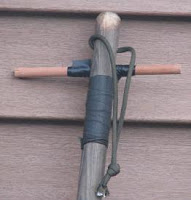I have taken a shining to the words of this magnificent woman. She has Epilepsy and is open to sharing her experiences, the questions that co-exist with the experience and her many achievements. She writes her own blog 'E. is for Epilepsy by Paula Apodaca' and is able to manipulate the english language to create a signature of understanding and motivation!
Paula Apodaca
In the late 1970's, Peter Conrad and Joseph Schneider were in the field, researching the experience of epilepsy. They concentrated their search for informants on the middle states and were rewarded with an overall participant pool of about 80 persons willing to talk about their lives with epilepsy. Having Epilepsy: The Experience and Control of Illness published in 1983 and the authors were heralded for their work.
When I read the book, some 20 years later, I was surprised by the singular nature of this work: Epilepsy is a disorder much written of and endlessly researched from medical, surgical, and pharmacological points of view, but rarely from a sociological stand point. For me, the book was a real page-turner. Yet, even as much as I liked the work, it seemed to me that it missed something essential: a discussion of key issues unique to the experience of "E." (epilepsy). That's what this blog is for, to talk about some of those key issues that create the essence of one's experience with E..
So, let's talk about them. But first, let's define our terms---after all, we have to agree on the language we will use if we are to understand each other clearly. I have over 50 years experience with E., and it should come in handy. Let me tell you how I realized the way the naming of epilepsy was setting up a barrier to any effective or meaningful dialogue about E.: As a child, it was carefully explained to me by my mother and my first few doctors that I had epilepsy, that I experienced grand mal and petit mal seizures, and that I wold never get over it. In my teens, I learned that I had left temporal lobe epilepsy that expressed itself as both grand mal and petit mal seizures but I was fortunate because my seizure activity came with an aura. As a young woman I was informed that all of this was wrong: what I had was epilepsy, certainly, but it had a left temporal lobe focus, and I suffered grand mal with an aura, petit mal and psychomotor seizure activity.
Today, I have simple and complex partial seizures which secondarily generalize into tonic-clonic episodes, accompanied by psychomotor episodic events. Over the span of my lifetime, my diagnosis has never changed, but the language used to describe it has.
Conrad and Schneider refer to a modernization of terms for epilepsy at the beginning of their book. They point out that some sets of terms are older than others. I feel compelled to point out that just since the publication of their book in 1983, the august body in charge of creating the lexicon used to describe epilepsy has ratified changes at least twice more and is likely to do so again, as soon as this year. As I count it, that makes at least four changes to the language used to name and describe epilepsy in less than 30 years.
Who are these folks? They are the International League Against Epilepsy. To be fair, this active phase of taxonomic refinement is a reflection of the outcomes of research and knowledge growth from within the medical community. But while changes to the language serve and enrich communications between clinicians and researchers, it has a paradoxical effect on those who live with E. because it enhances our sense of isolation from everyone else. After all, how do you begin to talk about your disorder if you can't simply use terms readily accessible to ordinary, non-medicalized folks?
Well, perhaps those kind of conversations can wait. The first set of conversations a person with E. can expect to have will be with one's doctors. You think: This should be easy. After all, E. is an ancient, well-recognized disorder, written about for thousands of years, diagnosed by Hippocrates the Greek and later by Galen the Roman. Not to mention it's New Testament references. So, it is reasonable to expect a clear, easy-going conversation from one's physician. True?
Not true. In fact, most persons experienced with E. have a broader working knowledge of this disorder than do many doctors, regardless whether they are generalists or specialists.
But, here's a tip offered by many of us experienced with E.: if you have an appointment with a doctor and you use words he doesn't seem to understand, or if he uses terms you recognize from before the 1970's, he is probably not the doctor for you. His use of diagnostic terms can tell you how seriously he takes E., how well he will treat you as a patient, and whether or not he has kept abreast of current treatments.






